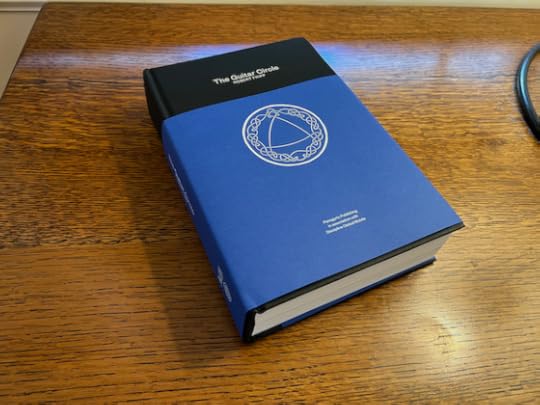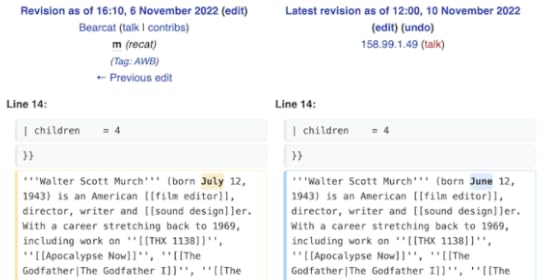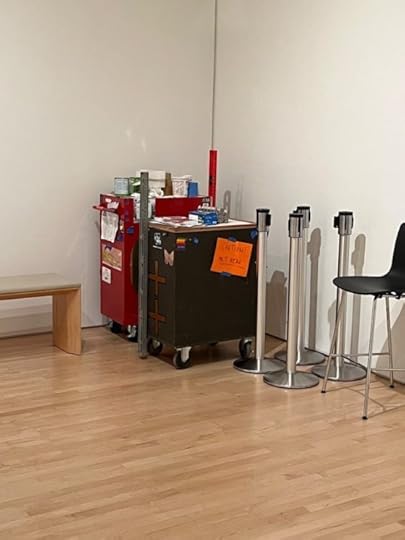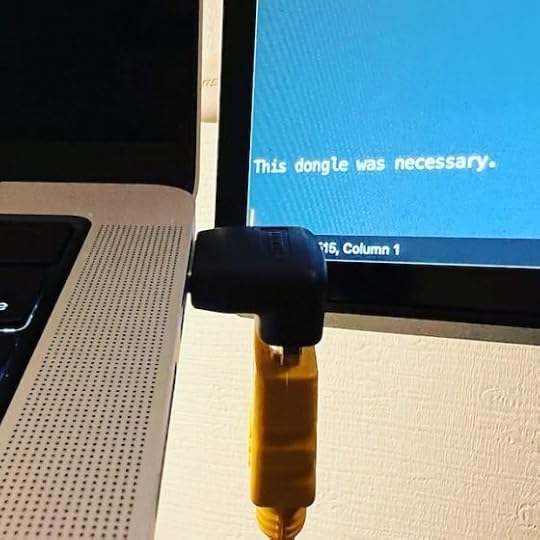Marc Weidenbaum's Blog, page 123
November 15, 2022
Sound Ledger¹ (Subtitles, Thailand)
50: Percent of TV viewers using subtitles
55: Percent who find TV dialogue hard to hear
189: Number of noise complaints to Thailand’s Pollution Control Department this year from Bangkok, the capital (and noisiest city in the nation), out of a total of 718 (down from 766 last year)
________
¹Footnotes
Subtitles: avclub.com, preply.com. Thailand: bangkokpost.com.
November 14, 2022
Carrie Schneider Watches and Listens as Women Read
I spent Friday, which we had off for Veterans Day, across the bridge in Oakland at one of the Bay area’s many excellent museums, in this case the somewhat awkwardly named Oakland Museum of California, which is housed in one of the most playful brutalist structures I’ve ever had the pleasure of learning the ins and outs of over the years.
The museum is very much “of California.” While it contains, and displays, a lot of art, it is as much a history museum. And while it is a history-oriented institution, with an engaging permanent section dedicated to the state’s deep, broad, and — by some relative measures — brief through lines, it is also a visually motivated institution. Which is to say, the current Angela Davis — Seize the Time exhibit (running through June 11, 2023) is as much about an icon — emphasis on that eclipsing silhouette of hair — as it is about the lived experience of a transformative political figure. To that end, Seize the Time mixes art about and related to Davis (paintings, prints, photographs, video, installations) with artifacts from her own life (news footage, publications, posters, video, interviews).
And there is a lot of sound, so much so that individual galleries within the Seize the Time exhibit have both a speaker and headphones, so visitors can separate the different pieces of work.

Page Turner: One of the women reading one of the books in Carrie Schneider’s Reading Women
A favorite piece of mine was Reading Women (Angela Davis/Prison Abolition Edit), a short film by Carrie Schneider projected on one of the museum walls. Just under seven minutes in length, the film presents carefully edited footage of women reading. And that’s it. They’re reading Davis’ books, and they sit, in the plain light of day, with the physical object in hand, turning the page, taking it in, reflecting, and turning another page.
Throughout, there is the natural sound of the moments: fingers on paper, the odd hmmm, a piece of paper moving, a seat being adjusted — and, of course, the great emotional barometer known as room tone. We listen to the rooms in which these women sit as much as we watch the women.
Reading Women reminded me a bit of some of Yoko Ono’s video art, and Andy Warhol’s, which can focus on quotidian instances. But Ono and Warhol are powerful — perhaps instinctual — visual designers, whereas Schneider is much more interested in the naturalist intimacy of the moment. Reading Women isn’t a documentary in any way, but it’s also more than a document. It’s documentarian in the manner by which it captures these moments, and maps contrasts and parallels while different eyes, different faces, different minds, respond to similar words.
It’s unfortunate that of the pieces in the Angela Davis show, Reading Women is one that is presented with speakers instead of headphones, because the sounds are so subtle. But if you can make it to the museum on a weekday, when there’s no one else around, this is a vicarious book club you’ll want to join for sure.
November 13, 2022
Robert Fripp’s Rules of Order
Few if any had “Robert Fripp becomes an internet romantic icon” on their pandemic bingo card. And yet the guitarist — as much known for his work with David Bowie and Brian Eno as for his prog-rock reign, since 1968, in the band King Crimson — spent much of the past two or more years with his wife Toyah Willcox entertaining the locked down, the self-quarantined, and the remote-working. The frisky duo’s popular YouTube videos feature humorous cover versions, barely covered nipples, and enough costumes to fill a stately British home.
Fripp apparently also spent a chunk of the unexpected break from touring by collating his voluminous past writing on the topic of guitar instruction. A new tome, the 561-page The Guitar Circle, serves to balance his recently acquired goofy public persona with a heady dose of artistic philosophy. Out with the new, in with the old?

Bible Black: Robert Fripp’s 561-page tome about what he’s learned from teaching guitar
The book is neither tutorial nor autobiography. Don’t pick it up if you’re looking for sheet music or tour anecdotes. It is, instead, largely pre-existing material providing a mosaic account of Fripp’s perspective on music instruction. There are speeches, and entries from his ongoing dgmlive.com diary, and documents once created to orient attendees of the courses, originally named Guitar Craft, that he developed. (Guitar Circle was a subsequent rebranding. That the book doesn’t take a moment, at the start, to spell out Fripp’s decades of music instruction says something about its assumed audience.) Leavening patrician prickliness with whimsical self-effacement, he even includes a chapter of letters he wrote to disgruntled students, whom he charitably leaves anonymous.
And there are lists, of which Fripp seems quite fond. He delineates “Four Qualities of Refusal,” “Six Strategies of Practicing,” and “Nine Stages of Approaching Silence.” The book’s sole illustration is a list in visual form: a “Tetrad of the Orchestra of Crafty Guitarists.” His favorite number appears to be seven. There are “Seven Assumptions for Work in the Circle,” “Seven Lies of the Devil,” “Seven Views of Charisma,” and “Seven Affirmations.”
The most cited list here is so natural to Fripp that he often leaves it nameless. He simply and repeatedly — a dozen or so times — refers to “head, hand, and heart” as the three “instruments” of a musician. This is the book’s crux: musicians — and by extension all practitioners of a craft — must attend to their intellect and emotions as much as to their skills. (We know Fripp’s a romantic from his amorous videos with Willcox, but it’s still notable how prominent a role “love” plays in The Guitar Circle. The word appears almost as often as “discipline.”) The innumerable entries can be summarized as follows: practice, and if you don’t want to practice, sit with yourself for a while and then practice.
The book, a veritable mountain of aphorisms, evidences the discipline — that quintessential Fripp word — of someone who doesn’t merely record his thoughts but who scrutinizes and refines them. (Artists and bloggers alike should read him on the benefits of keeping a diary in public. “Maintaining a diary,” he writes, “is itself a process, of engagement with oneself.”) What it doesn’t evidence is editorial discipline: as in music composition, context and economy would have given his theoretical riffs meaningful structure. The Guitar Circle is best read as it was written: over an extended period of time, a bit at a time.
(My article first appeared, in ever so slightly different form, in the November 2022 issue of The Wire.)
November 12, 2022
Scratch Pad: Guitar, Accents, Mastodon
I do this manually each Saturday, usually in the morning over coffee: collating most of the little comments I’ve made on social media during the preceding week. I’ve long thought of social media — Twitter especially, though I’m taking a break, and Facebook to a degree, and increasingly Mastodon — as my public notebook. Or more to the point, my public “scratch pad,” which seems a degree more rough and unformed than a “notebook” suggests. I’ve found it personally informative to revisit the previous week of thinking out loud in public. Also, I think knowing you’ll revisit what you say pulls in the reins a bit, in a good way, on what you do say.
What appears here isn’t a full accounting. Often there are, for example, conversations online that don’t really make as much sense out of the context of social media itself. Some of my notes pop up sooner in expanded form or otherwise on Disquiet.com, and others I delay repeating to flesh them out further. And sometimes I tweak them a bit, given the additional space. And sometimes I re-order them.
▰ Dante would have written a very different book had he experienced the hell that is losing one’s place in an audiobook
▰ I know I’m getting at least slightly better on guitar because my mistakes sound better
▰ Remember when it was not just possible but fairly straightforward to own every Morton Feldman recording? To check my memory, I looked at Discogs.com. There were roughly 15 between 1957 and 1990 (three years after his death). Then the damn broke, and these are loose numbers: 1991(7), 1992 (6), 1993 (4), 1994 (11), and onward. We’re just over three years from the centenary of Feldman’s birth (January 12, 1926), and presumably there will be a full-on (and entirely welcome) overload.
▰ Love this place, the Oakland Museum of California

▰ There’s a new Christina Vantzou album out, and as always it is willfully less than the sum of its parts: substantial classical instrumentation, ethereal vocals, and textural electronics all coaxed to a sublime, minimal state (Thanks to A Closer Listen for the alert.)
▰ Ending the day with some Madeleine Cocolas. See you crazy kids tomorrow.
▰ The bird ate a bad worm

▰ Apparently Wikipedia has had the month of Walter Murch’s birth incorrect for some time?

▰ I want to hear Janet Cardiff’s Forty‑Part Motet on these new Teenage Engineering wooden speaker tchotchkes.

▰ Afternoon work listening: the soundtrack by Hania Rani to the documentary film Venice: Infinitely Avant-Garde. There’s a strong Philip Glass influence, but far more to it than that: shifting layers of precise arrangements, strong emphasis on the slightest touches. Absolutely beautiful
▰ I marvel when the rev.com transcription service supplies these limited options. Fascinating what common accents aren’t mentioned (Spanish? Russian? German?), how Asian is one broad swath, and yet British (which is broad unto itself) and Australian (the entire country has 2/3rds of the population of the Tokyo metropolitan area) get separated. (And yes, there’s an option for “other.)

▰ Nostalgia is a hell of a drug
▰ Somehow managed to put “.com” instead of “.org” when mentioning Lurk in my This Week in Sound email
▰ Today in guitar class: more of “Someone to Watch Over Me,” options for the Dbmaj7 chord, using a single fret for the pentatonic (major and minor), and related topics.
▰ How to get multi-column Mastodon view in your browser

▰ Good reason to leave the house

▰ My columns in the Mastodon browser app:
NotificationsLocal Timeline
Home*
Hashtags**
Bookmarks
DMs
*home is people one follows
**currently:
#soundstudies
#fieldrecording
#machinelistening
#supercollider
▰ Rain to the left of me, dishwasher to the right, stuck in the middle with some old Nils Frahm on the laptop (which has remarkably good speakers).
▰ Listened to Music for Animals, by Nils Frahm, all over again this weekend. One of my favorite albums of the year. Quiet music to be played loud, so you can track the details. Also just to be played in the background. It fills the room while I read.
Music For Animals by Nils Frahm
▰ Sometimes the best moments at modern art museums is when you’re not sure if it’s an installation or just a corner where work is yet to be completed. These come more readily if a room or two away you’d just been staring at some Rauschenbergs.

▰ First visit to SFMOMA since the before times. Made sure to spend time in my favorite spot there — and in some ways my favorite spot in the entire city. Here are five (well, three plus two halves) of the seven walls of the Agnes Martin room.

▰ Dongle needed:

November 11, 2022
Finding Quiet Places with the SoundPrint app
Have you ever found yourself wanting some quiet time, perhaps in an unfamiliar town, and not known where to go? The app SoundPrint (available for iOS and Android: soundprint.co) is a crowdsourced service that rates locations — with an apparent emphasis on eateries — by their relative volume and din. And unlike Yelp reviews, where your favorite local spot gets downgraded because an entitled out-of-town grouch wanted the waiter to smile more, SoundPrint’s core information is primarily quantified in nature, rather than anecdotal.
To participate in rating a place, you click the SoundCheck button, to which you feed at least 15 seconds of uninterrupted sonic mise-en-scène. Your individual data is then processed and collated alongside previously submitted user data. When you click through to a specific location, you see all the SoundChecks to date, plotted by time period within a given day. It’s not an exact science by any means, but it’s a good enough gauge whether a given coffee shop doubles as a heavy-metal meet-up, and if a nearby museum’s restaurant is hermetic or boisterous.
When you do a local search, the locations pop up with color-coded, numerical ratings that represent averages of the submitted information. A search of my neighborhood definitely aligned with my personal experience:

App-etizers: Note the color-coded decibel levels
The restaurant Steins, for example, while often playing some alien-to-me sports event on a huge TV behind the bar, is quite large, with a high ceiling that provides space for sound to disappear into. Chili House (one of my two favorite Sichuan restaurants in San Francisco, I should mention — the other being the quieter Sichuan Home) can, indeed, get exceedingly loud, with packed tables and a generally upbeat clientele. (For the record, I’m still living pandemic-style and eating outdoors. Chili House, fortunately, has its own dedicated parklet.)
The design of SoundPrint’s layout is worth looking at more closely. Not only are there decibel levels (69 for Steins, 91 for Chili House), there are colors that make the relative volumes easier to distinguish at a glance. In addition, some places, like the Richmond (which is, indeed, very quiet), get highlighted thanks to user nominations.
The one thing that stands out to me, at this phase of the SountPrint app’s development, is how the decibels are given such weight. Most people aren’t familiar with the meaning implicit in the numbers, and so users may not recognize that 61 is, in fact, quite quiet for a restaurant. I could imagine a situation where, in the future, either people do come to understand those numbers, or the app diminishes their prominence in favor of colors and some other form of data visualization — perhaps like how in Los Angeles an A, B, or C serves as shorthand for the top 30% of food-safety ratings, with the numerical score posted only for those that get a 69 or under (at least that’s how I think it works).
As with any crowdsourced app, SoundPrint will only be as good as its users — unless, of course, Nest or Siri or other digital assistant gadget gets involved, and locales start submitting their own realtime data. And if such a thing happens, then there will be inevitable scandals about how some restaurant is feeding recordings of empty rooms into SoundPrint to cheat the system. Which now that I type it, seems more likely than not.
November 10, 2022
Disquiet Junto Project 0567: Three Meters

Each Thursday in the Disquiet Junto music community, a new compositional challenge is set before the group’s members, who then have just over four days to upload a track in response to the assignment. Membership in the Junto is open: just join and participate. (A SoundCloud account is helpful but not required.) There’s no pressure to do every project. It’s weekly so that you know it’s there, every Thursday through Monday, when you have the time.
Deadline: This project’s deadline is the end of the day Monday, November 14, 2022, at 11:59pm (that is, just before midnight) wherever you are. It was posted on Thursday, November 10, 2022.
Tracks are added to the SoundCloud playlist for the duration of the project. Additional (non-SoundCloud) tracks appear in the llllllll.co discussion thread.
These are the instructions that went out to the group’s email list (at tinyletter.com/disquiet-junto):
Disquiet Junto Project 0567: Three Meters
The Assignment: Make music in 5/8, 6/8, and 7/8 time signatures.
Thanks to Łukasz Langa (aka RPLKTR) for instigating this project.
Step 1: The week this project is published, the Disquiet Junto will be doing its 567th consecutive weekly project. Think about those digits and how they relate to each other.
Step 2: Record a piece of music that moves between — and perhaps even overlays — 5/8, 6/7, and 7/8 time signatures.
Eight Important Steps When Your Track Is Done:
Step 1: Include “disquiet0567” (no spaces or quotation marks) in the name of your tracks.
Step 2: If your audio-hosting platform allows for tags, be sure to also include the project tag “disquiet0567” (no spaces or quotation marks). If you’re posting on SoundCloud in particular, this is essential to subsequent location of tracks for the creation of a project playlist.
Step 3: Upload your tracks. It is helpful but not essential that you use SoundCloud to host your tracks.
Step 4: Post your track in the following discussion thread at llllllll.co https://llllllll.co/t/disquiet-junto-project-0567-three-meters/
Step 5: Annotate your track with a brief explanation of your approach and process.
Step 6: If posting on social media, please consider using the hashtag #DisquietJunto so fellow participants are more likely to locate your communication.
Step 7: Then listen to and comment on tracks uploaded by your fellow Disquiet Junto participants.
Step 8: Also join in the discussion on the Disquiet Junto Slack. Send your email address to marc@disquiet.com for Slack inclusion.
Note: Please post one track for this weekly Junto project. If you choose to post more than one, and do so on SoundCloud, please let me know which you’d like added to the playlist. Thanks.
Additional Details:
Deadline: This project’s deadline is the end of the day Monday, November 14, 2022, at 11:59pm (that is, just before midnight) wherever you are. It was posted on Thursday, November 10, 2022.
Length: The length is up to you. Perhaps something to do with 5, 6, and 7?
Title/Tag: When posting your tracks, please include “disquiet0567” in the title of the tracks, and where applicable (on SoundCloud, for example) as a tag.
Upload: When participating in this project, be sure to include a description of your process in planning, composing, and recording it. This description is an essential element of the communicative process inherent in the Disquiet Junto. Photos, video, and lists of equipment are always appreciated.
Download: It is always best to set your track as downloadable and allowing for attributed remixing (i.e., a Creative Commons license permitting non-commercial sharing with attribution, allowing for derivatives).
For context, when posting the track online, please be sure to include this following information:
More on this 567th weekly Disquiet Junto project — Three Meters (The Assignment: Make music in 5/8, 6/8, and 7/8 time signatures) — at: https://disquiet.com/0567/
More on the Disquiet Junto at: https://disquiet.com/junto/
Subscribe to project announcements here: https://tinyletter.com/disquiet-junto/
Project discussion takes place on llllllll.co: https://llllllll.co/t/disquiet-junto-project-0567-three-meters/
The cover image for this project is from DALL·E 2, where “three rulers, colorful photograph” was the prompt.
November 9, 2022
This Week in Sound: He Used to Bite His Music Boxes
These sound-studies highlights of the week originally appeared in the November 8, 2022, issue of the free Disquiet.com weekly email newsletter This Week in Sound: thisweekinsound.substack.com.
▰ THE WHOLE TOOTH: Robert Friedman, the owner of a piano that once belonged to Thomas Edison, spoke with NPR’s Scott Simon about its bite marks — which are reputed to be those of Edison himself. (Thanks, Rich Pettus!)
Friedman: He used to bite his music boxes, and he bit his piano. …
Simon: I’m trying to imagine anyone, much less Thomas Edison, with their mouth clamped on a piano.
Friedman: The sensation is amazing. It goes up through your skull, your head resonates like a tuning fork. It’s an amazing feeling. It goes through your shoulders, but you get the true vibration of the instrument, and you hear the piano equal, if not better, than if you just hear it through your ears.
▰ HEY BALE: Mark Gurman, Bloomberg reporter, foresees Apple simplifying the voice command for Siri:
“The company is working on an initiative to drop the ‘Hey’ in the trigger phrase so that a user only needs to say ‘Siri’ — along with a command. While that might seem like a small change, making the switch is a technical challenge that requires a significant amount of AI training and underlying engineering work. … The complexity involves Siri being able to understand the singular phrase ‘Siri’ in multiple different accents and dialects. Having two words — ‘Hey Siri’ — increases the likelihood of the system properly picking up the signal.”
▰ FIELD’S RECORDING: Details on the sound design of Todd Field’s new film Tár, starring Cate Blanchett as a conductor-composer: the director wants the audience “to feel [Hildur Guðnadóttir’s score] but almost not hear it”; Blanchett’s title character has misophonia (“which means she’s very sensitive to certain sounds”); omnidirectional microphones were used to record the symphony orchestra, “leaving the sound team more than 50 tracks to work with.”
▰ QUIET TIME: Check out this gallery, on the Dezeen (as in “design”) website, of 10 different “noise-regulating acoustic products for communal interiors.”

Felt Up: The Fost Bulb PET Felt acoustic lamp from De Vorm “provides both sound dampening and illumination.”
Included in the Dezeen feature are office booths, felt light shades, a sensory nook (called the “Sensory Nook,” natch), panels, and more.
▰ TAP DANCE: “After continually deflecting accusations that it surveilled droves of politicians and journalists using invasive phone-tapping software, the Greek government has decided to ban the sale of spyware altogether. But the government also wants everybody to know that this is in no way an admission of guilt and that it definitely didn’t do anything wrong” — is how Gizmodo sums up a recent scandal.
▰ WATER TORTURE: “In the US border town of Niagara Falls, residents accustomed to the soothing roar of the famous waterfalls recently discovered a much less pleasant sound: the ‘haunting hum’ of bitcoin mining farms.” The miners were reportedly attracted by the area’s “cheap hydroelectric power.” Comments from residents:
“It’s very mentally daunting. It’s like having a toothache for 24 hours a day every day.”
“I get four hours of sleep, maybe, because of that constant noise.”
“I’m going to be protesting till the hum is gone, basically, till I get the roar of the falls back because that’s what I used to hear.”
▰ VISUAL HEARING AID: There was a great multimedia piece in the Washington Post that explores what hearing loss is like — and it does so by visualizing the experience. The article is credited to Amanda Morris, a reporter, and Aaron Steckelberg, a “senior graphics reporter” (what a cool job), who did the visuals. No subscription necessary to see it, as I can share this gift link. Audiograms and other graphic aids tell the story, such as how the siren is situated on the chart reproduced below.

Freq Out: This example of a Washington Post chart situates the pitch and volume of a passing siren
The horizontal axis “maps the pitches that are audible to your ears, from low-pitched sounds, shown on the left, to high-pitched sounds, shown on the right.” The vertical axis is the volume level in decibels.
▰ AUTO MOTIVE: SlashGear’s Alistair Charlton is not excited about the broadening array of voice recognition systems in cars: “[C]ar manufacturers’ own voice recognition systems? They’re less than stellar. These are often summoned by saying ‘hey’ and the vehicle manufacturer’s name. … Siri is a made up name, and no one goes about their day saying ‘Okay Google’ unless they want to talk to the Google Assistant. But in the car? You’re quite likely to mention the brand of the vehicle you’re in when talking to a passenger, or when you see another one out on the road. Before you know it, your music is muted and the car is listening when you don’t want it to. We might forgive all this if car manufacturers made decent voice assistants, but it’s the tech firms who have the upper hand here. Please, automakers of the world, stick to Alexa, Google Assistant or Siri and leave it at that.” (Just as a side note: I’m not remotely likely to say the name of my car to a passenger, but I’m not much of a car person.)
November 8, 2022
Sound Ledger¹ (Noise, Branding)
4,858: Number of tickets issued for vehicular noise pollution in Islamabad, Pakistan, in the past six months
500,000: The number of consumer surveys that make up an an AI-powered service that aims to “predict the granular emotional impact of music” (it’s called OnBrand)
12,000,000: The number of “datapoints” in the OnBrand algorithmic engine
________
¹Footnotes
Islamabad: thenews.com.pk. OnBrand: musically.com
November 7, 2022
Guitar as Graphic Notation

After working in this little rental office for a while I realized I hadn’t been practicting guitar as much so I bought a used electric guitar from someone who plays in a funk band and was about to become a parent for the first time. These are the markings of the previous owner’s belt buckle on the back of the guitar (it’s a Telecaster, so it’s got a very flat, even back). I love the idea of such scratches being a kind of reverse transcription: musical notation after the fact; the imprint of performance rather than directions for a performance.
November 6, 2022
The Magic Number
Sounds previously considered illusions have turned out to exist. “A musical sound once thought to be heard only in our heads as a quirk of the ear canal is actually real,” writes Karmela Padavic-Callaghan at the New Scientist. “Violins can produce these unusual tones – and higher quality violins can produce them more strongly.” Padavic-Callaghan explains that questions about this third tone — eventually called a “combination tone” — date back over 300 years, to a discovery in 1714 by Giuseppe Tartini (1692-1770), a Baroque-era Italian violinist and composer.
A newly published article in The Journal of the Acoustical Society of America is the source of the New Scientist piece. Interestingly, in the work of the scientists exploring the subject, it turned out that older instruments produced more prominent third notes.
To put this discovery (credited to Gabriele Caselli, Giovanni Cecchi, and Giulio Masetti) in context, a distinction has now been made between what we experience as heard versus what is actually present in the world. It would be one thing if the sound exists only because of how our ears are structured (“It was thought that these tones arose entirely in our ears, due to the way sound is amplified by the cochlea, rather than actually emanating from an instrument”). In contrast, the violins actually produce this previously mysterious sound. The discovery both upends a long-held misapprehension, and potentially opens up compositional techniques for composers who wish to exploit this sonic phenomenon. (Thanks, Glenn Sogge!)



